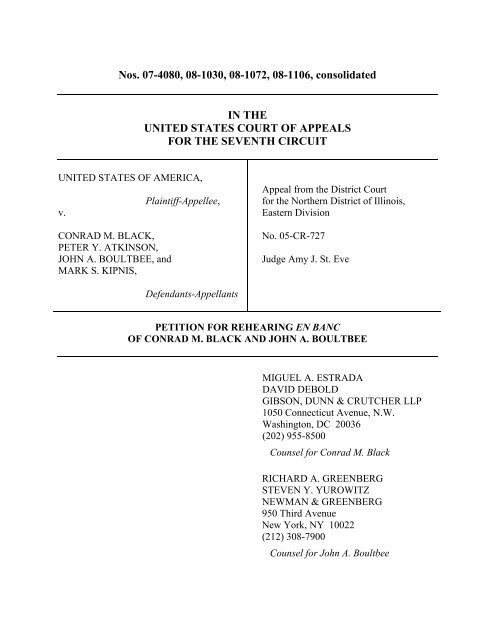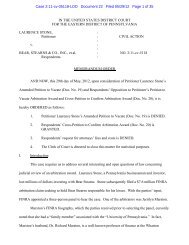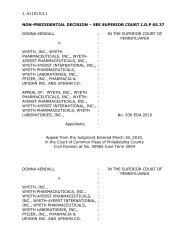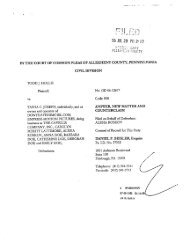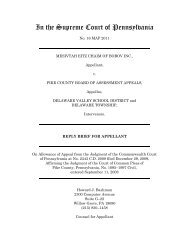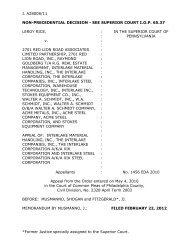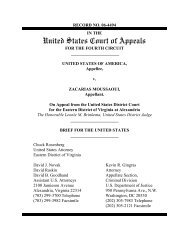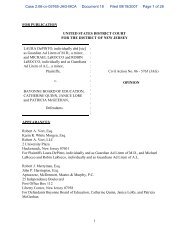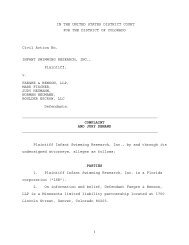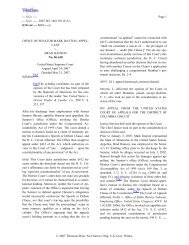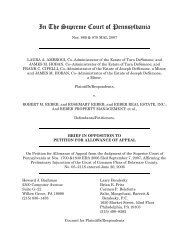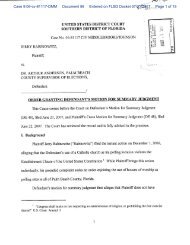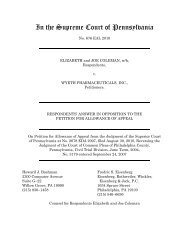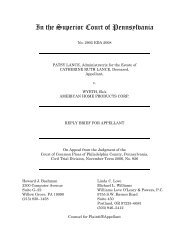petition for rehearing en banc - How Appealing
petition for rehearing en banc - How Appealing
petition for rehearing en banc - How Appealing
You also want an ePaper? Increase the reach of your titles
YUMPU automatically turns print PDFs into web optimized ePapers that Google loves.
Nos. 07-4080, 08-1030, 08-1072, 08-1106, consolidated<br />
UNITED STATES OF AMERICA,<br />
v.<br />
CONRAD M. BLACK,<br />
PETER Y. ATKINSON,<br />
JOHN A. BOULTBEE, and<br />
MARK S. KIPNIS,<br />
IN THE<br />
UNITED STATES COURT OF APPEALS<br />
FOR THE SEVENTH CIRCUIT<br />
Plaintiff-Appellee,<br />
Def<strong>en</strong>dants-Appellants<br />
Appeal from the District Court<br />
<strong>for</strong> the Northern District of Illinois,<br />
Eastern Division<br />
No. 05-CR-727<br />
Judge Amy J. St. Eve<br />
PETITION FOR REHEARING EN BANC<br />
OF CONRAD M. BLACK AND JOHN A. BOULTBEE<br />
MIGUEL A. ESTRADA<br />
DAVID DEBOLD<br />
GIBSON, DUNN & CRUTCHER LLP<br />
1050 Connecticut Av<strong>en</strong>ue, N.W.<br />
Washington, DC 20036<br />
(202) 955-8500<br />
Counsel <strong>for</strong> Conrad M. Black<br />
RICHARD A. GREENBERG<br />
STEVEN Y. YUROWITZ<br />
NEWMAN & GREENBERG<br />
950 Third Av<strong>en</strong>ue<br />
New York, NY 10022<br />
(212) 308-7900<br />
Counsel <strong>for</strong> John A. Boultbee
TABLE OF CONTENTS<br />
RULE 35 STATEMENT .................................................................................................... 1<br />
ARGUMENT...................................................................................................................... 4<br />
A. The “Honest Services” Instruction Prejudiced Def<strong>en</strong>dants<br />
on All Fraud Counts .................................................................................... 6<br />
B. There Is More Than A Reasonable Possibility That The<br />
Legal Error In The Fraud Instruction Affected The Closely<br />
Intertwined Obstruction Conviction ......................................................... 12<br />
CONCLUSION................................................................................................................. 15
Cases<br />
TABLE OF AUTHORITIES<br />
Page(s)<br />
Arizona v. Fulminante,<br />
499 U.S.275 (1991)..........................................................................................................5, 7<br />
Bachellar v. Maryland,<br />
397 U.S. 564 (1970)...........................................................................................................14<br />
Cali<strong>for</strong>nia v. Roy,<br />
519 U.S. 2 (1996).................................................................................................................4<br />
Carella v. Cali<strong>for</strong>nia,<br />
491 U.S. 263 (1989).......................................................................................................4, 12<br />
Chapman v. Cali<strong>for</strong>nia,<br />
386 U.S. 18 (1968).....................................................................................................1, 5, 11<br />
Griffin v. United States,<br />
502 U.S. 46 (1991).............................................................................................................14<br />
Harrington v. Cali<strong>for</strong>nia,<br />
395 U.S. 250 (1969).............................................................................................................5<br />
Hedgpeth v. Pulido,<br />
129 S. Ct. 530 (2009)...........................................................................................................1<br />
Kotteakos v. United States,<br />
328 U.S. 750 (1946).............................................................................................................4<br />
Neder v. United States,<br />
527 U.S. 1 (1997).............................................................................................................1, 5<br />
Pope v. Illinois,<br />
481 U.S. 497 (1987).............................................................................................................6<br />
Rose v. Clark,<br />
478 U.S. 570 (1986).................................................................................................1, 2, 4, 5<br />
Sandstrom v. Montana,<br />
442 U.S. 510 (1979).............................................................................................................7<br />
Sullivan v. Louisiana,<br />
508 U.S. 275 (1993).........................................................................................................1, 5
TABLE OF AUTHORITIES (continued)<br />
Page(s)<br />
United States v. Acker,<br />
52 F.3d 509 (4th Cir. 1995) .................................................................................................2<br />
United States v. Aguilar,<br />
515 U.S. 593 (1995)...........................................................................................................13<br />
United States v. Arthur Anders<strong>en</strong>,<br />
544 U.S. 696 (1995)...........................................................................................................13<br />
United States v. Manning,<br />
23 F.3d 570 (1st Cir. 1994)..................................................................................................2<br />
United States v. Martin Lin<strong>en</strong> Supply Co.,<br />
430 U.S. 564 (1977)...................................................................................................................5<br />
United States v. Matthews,<br />
505 F.3d 698 (7th Cir. 2007) .............................................................................................12<br />
United States v. Slade,<br />
627 F.2d 293 (D.C. Cir. 1980) .............................................................................................2<br />
United States v. Vonn,<br />
535 U.S. 55 (2002)...........................................................................................................1, 6<br />
In re Winship,<br />
397 U.S. 358 (1970).............................................................................................................4<br />
Yates v. Evatt,<br />
500 U.S. 391 (1991).............................................................................................1, 5, 6, 7, 8<br />
Yates v. United States,<br />
354 U.S. 298 (1957)...........................................................................................................14<br />
Statutes<br />
18 U.S.C. § 1512(c)(1) ............................................................................................................12
RULE 35 STATEMENT<br />
Conrad M. Black and John A. Boultbee respectfully <strong>petition</strong> <strong>for</strong> <strong>rehearing</strong> <strong>en</strong> <strong>banc</strong> of a<br />
decision r<strong>en</strong>dered by a panel of this Court (Posner, Kanne, & Sykes, JJ.) on October 29,<br />
2010, following a reversal and remand by the United States Supreme Court. The Supreme<br />
Court unanimously ruled that one of the two alternative theories of mail fraud that were pre-<br />
s<strong>en</strong>ted to the jury is not a federal crime, and it remanded <strong>for</strong> consideration of whether the<br />
governm<strong>en</strong>t can establish harmlessness beyond a reasonable doubt. On remand, the panel<br />
ruled that while the error was prejudicial as to two counts of fraud, it was harmless as to the<br />
only remaining fraud count on which the jury convicted (count 7) as well as one count of ob-<br />
struction of justice, which applies to Black alone (count 13).<br />
The panel’s decision warrants <strong>en</strong> <strong>banc</strong> review under FRAP 35(a)(1) because every perti-<br />
n<strong>en</strong>t Supreme Court decision in the last 40 years, beginning with Chapman v. Cali<strong>for</strong>nia, 386<br />
U.S. 18 (1967), has rejected the mode of harmless error analysis embraced by the panel. See,<br />
e.g., Rose v. Clark, 478 U.S. 570, 578 (1986); Yates v. Evatt, 500 U.S. 391, 404-05 (1991);<br />
Sullivan v. Louisiana, 508 U.S. 275, 279 (1993). Review is also warranted under FRAP<br />
35(a)(2) to resolve a question of exceptional importance: Wh<strong>en</strong> a jury is instructed, in viola-<br />
tion of the Due Process Clause of the Fifth Am<strong>en</strong>dm<strong>en</strong>t, that it may convict of conduct that is<br />
not a crime, is it consist<strong>en</strong>t with the jury-trial right guaranteed by Article III and the Sixth<br />
Am<strong>en</strong>dm<strong>en</strong>t <strong>for</strong> an appellate court to deem the error “harmless” based on its own favorable<br />
assessm<strong>en</strong>t of the persuasive power of the governm<strong>en</strong>t’s case, without accounting <strong>for</strong> the<br />
evid<strong>en</strong>ce supporting the def<strong>en</strong>se or the fact that the jurors who actually heard that evid<strong>en</strong>ce<br />
acquitted def<strong>en</strong>dants on almost every charge—including those where they necessarily re-<br />
jected the same evid<strong>en</strong>ce on which the panel relied? See, e.g., Neder v. United States, 527<br />
U.S. 1, 15-16 (1999) (harmlessness review must be conducted “on the whole record”);<br />
United States v. Vonn, 535 U.S. 55, 68 (2002) (“<strong>en</strong>tire record be<strong>for</strong>e the reviewing court”);<br />
Hedgpeth v. Pulido, 129 S. Ct. 530, 533 n.* (2008) (“record as a whole”).
With respect to Count 7, the panel variously described the def<strong>en</strong>se evid<strong>en</strong>ce and argu-<br />
m<strong>en</strong>ts as “implausible,” “decisively unbelievable,” and “clowning.” Slip op. at 12. It<br />
viewed the governm<strong>en</strong>t’s case, by contrast, as supported by the testimony of purportedly<br />
“disinterested” witnesses and “so compelling that no reasonable jury could have refused to<br />
convict the def<strong>en</strong>dants.” Id. at 12, 14. Appellate courts, however “are precluded from mak-<br />
ing indep<strong>en</strong>d<strong>en</strong>t credibility determinations on appeal.” United States v. Manning, 23 F.3d<br />
570, 575 (1st Cir. 1994). Juries, <strong>for</strong> their part, may “refuse” to convict on the governm<strong>en</strong>t’s<br />
evid<strong>en</strong>ce; any ruling to the contrary is an unvarnished violation of the Sixth Am<strong>en</strong>dm<strong>en</strong>t.<br />
Rose, 478 U.S. at 578 (Sixth Am<strong>en</strong>dm<strong>en</strong>t precludes directed verdicts ev<strong>en</strong> in cases where<br />
proof of guilt is overwhelming). The jury in this case did in fact “refuse” to buy a great ma-<br />
jority of what the governm<strong>en</strong>t was selling. It acquitted on every count that clearly dep<strong>en</strong>ded<br />
on a theory of “theft”: nine fraud counts charging that def<strong>en</strong>dants looted more than $50 mil-<br />
lion from Hollinger, two tax counts alleging that def<strong>en</strong>dants’ purported theft caused an un-<br />
derstatem<strong>en</strong>t on the corporate tax returns, and one RICO charge (against Black alone) whose<br />
predicate acts featured multiple allegations of interstate transportation of money tak<strong>en</strong> by<br />
fraud. In other circuits, such a sweeping rejection of the bulk of the governm<strong>en</strong>t’s case<br />
would be fatal to the governm<strong>en</strong>t’s claim that an error was harmless. See United States v.<br />
Acker, 52 F.3d 509, 518 (4th Cir. 1995); United States v. Slade, 627 F.2d 293, 308 (D.C. Cir.<br />
1980). Yet the panel did not m<strong>en</strong>tion it. Nor did it advert to the ample evid<strong>en</strong>ce supporting<br />
the theory of def<strong>en</strong>se that it derided, which included exculpatory testimony by the govern-<br />
m<strong>en</strong>t’s own star witness, David Radler. His name does not ev<strong>en</strong> appear in the panel opinion.<br />
The same suffici<strong>en</strong>cy-of-the-evid<strong>en</strong>ce methodology underlay the panel’s analysis of the<br />
obstruction count as to Black (Count 13). There was never any dispute that Black moved 13<br />
boxes out of his Toronto office—the <strong>en</strong>tire dispute was about why he did so. The govern-<br />
m<strong>en</strong>t cont<strong>en</strong>ded that he did it “corruptly”—i.e., to obstruct justice—because just one day ear-<br />
2
lier a lawyer <strong>for</strong> Black had learned that an SEC docum<strong>en</strong>t request was to issue. Black put on<br />
a def<strong>en</strong>se case that established: (1) he had a perfectly innoc<strong>en</strong>t reason <strong>for</strong> moving the boxes<br />
(Hollinger Inc. had evicted him from that office, and he had only six business days left to<br />
remove 27 years’ worth of belongings); (2) no one told him about the upcoming request,<br />
which was to be the SEC’s sixth request <strong>for</strong> docum<strong>en</strong>ts in the investigation; (3) he had faith-<br />
fully complied with the five previous docum<strong>en</strong>t demands, producing over 112,000 pages;<br />
(4) every docum<strong>en</strong>t in the Toronto office had be<strong>en</strong> examined, logged and, where relevant,<br />
produced to the governm<strong>en</strong>t by his lawyers (Sullivan & Cromwell); and (5) the boxes largely<br />
contained personal effects (such as estate papers <strong>for</strong> Black’s late brother).<br />
The panel was unpersuaded that a juror weighing hotly contested evid<strong>en</strong>ce on int<strong>en</strong>t was<br />
more likely to credit the prosecution’s theory if she believed, however wrongly, that Black<br />
was guilty of honest services fraud. Indeed, although the jury was instructed that this flawed<br />
fraud prosecution was one of the “official proceedings” on which an obstruction conviction<br />
could rest, the panel focused instead on other proceedings that could legally support a con-<br />
viction—an SEC or grand jury investigation. Slip op. at 4. And in focusing <strong>en</strong>tirely on the<br />
supposedly “compelling” governm<strong>en</strong>t case, the panel m<strong>en</strong>tioned only one of many def<strong>en</strong>se<br />
witnesses and th<strong>en</strong> solely to dismiss her testimony as “inconsist<strong>en</strong>t” with other evid<strong>en</strong>ce and<br />
biased. Slip op. at 5 (noting that Black’s secretary “loyally” supported his version of ev<strong>en</strong>ts).<br />
The panel’s erroneous analysis does not appear to have resulted from a misappreh<strong>en</strong>sion<br />
of the trial record, as distinct from its acceptance of the governm<strong>en</strong>t’s legal position that<br />
harmless error review c<strong>en</strong>ters on the purported str<strong>en</strong>gth of the governm<strong>en</strong>t’s case. Indeed,<br />
the panel grudgingly and “barely” reversed on the two “APC” fraud counts without ev<strong>en</strong> not-<br />
ing that Radler had consist<strong>en</strong>tly testified––in the grand jury and at trial—that the money in<br />
those counts was not stol<strong>en</strong>, or that the governm<strong>en</strong>t had previously def<strong>en</strong>ded those convic-<br />
tions expressly on the ground that the jury could believe Radler on this point and still find<br />
3
def<strong>en</strong>dants guilty solely due to honest services fraud. Because def<strong>en</strong>dants’ Rule 54 submis-<br />
sions already explained that the governm<strong>en</strong>t’s approach (now embraced by the panel) is in-<br />
consist<strong>en</strong>t with Supreme Court authority and the law of other circuits, only this Court <strong>en</strong><br />
<strong>banc</strong>, or the Supreme Court in due course, can now correct the panel’s errors.<br />
ARGUMENT<br />
The Supreme Court already ruled in this case that the jury instructions on honest-services<br />
fraud authorized conviction <strong>for</strong> conduct that is not a crime. That violation of the Due Proc-<br />
ess Clause of the Fifth Am<strong>en</strong>dm<strong>en</strong>t, see e.g., Carella v. Cali<strong>for</strong>nia, 491 U.S. 263, 265 (1989)<br />
(citing In re Winship, 397 U.S. 358, 364 (1970)), requires the governm<strong>en</strong>t to prove beyond a<br />
reasonable doubt that the jury in fact convicted on a proper basis—i.e., that the jury actually<br />
“has found, in Winship’s words, ‘every fact necessary’ to establish every elem<strong>en</strong>t of the of-<br />
f<strong>en</strong>se beyond a reasonable doubt.” Carella, 491 U.S. at 266 (citations omitted). The issue is<br />
not whether “the verdict could have be<strong>en</strong> the same without” the error, or whether “there was<br />
evid<strong>en</strong>ce suffici<strong>en</strong>t to support the verdict indep<strong>en</strong>d<strong>en</strong>tly of the [error’s] effect.” Yates, 500<br />
U.S. at 406-07 (emphasis added); id. at 407 & n. 7. Ev<strong>en</strong> with respect to non-constitutional<br />
errors, where the governm<strong>en</strong>t’s burd<strong>en</strong> of persuasion is far lighter, it has long be<strong>en</strong> the rule<br />
that “it is not the appellate court’s function to determine guilt or innoc<strong>en</strong>ce.” Kotteakos v.<br />
United States, 328 U.S. 750, 763-64 (1946); Rose, 478 U.S. 582 n.11 (“[T]he determination<br />
of guilt or innoc<strong>en</strong>ce, according to the standard of proof required by Winship and its prog<strong>en</strong>y,<br />
is <strong>for</strong> the jury rather than the court”). Thus, an error “cannot be r<strong>en</strong>dered harmless by the<br />
fact that, giv<strong>en</strong> the evid<strong>en</strong>ce, no reasonable jury would have found otherwise. To allow the<br />
error to be cured in this fashion would be to disp<strong>en</strong>se with trial by jury.” Cali<strong>for</strong>nia v. Roy,<br />
519 U.S. 2, 7 (1996) (Scalia & Ginsburg, JJ., concurring); see also Rose, 478 U.S. at 578<br />
(“the error in such a case is that the wrong <strong>en</strong>tity judged the def<strong>en</strong>dant guilty”); United States<br />
v. Martin Lin<strong>en</strong> Supply Co., 430 U.S. 564, 572-73 (1977).<br />
4
Because any application of the harmless error rule must be consist<strong>en</strong>t with the right to<br />
trial by jury, the Supreme Court has emphasized that the Chapman standard does not permit<br />
an appellate court to weigh the evid<strong>en</strong>ce, make credibility determinations, or consider only<br />
the evid<strong>en</strong>ce that it believes supports conviction while completely ignoring the case <strong>for</strong> the<br />
def<strong>en</strong>se. The str<strong>en</strong>gth of the governm<strong>en</strong>t’s case is relevant only insofar as it may show that<br />
the error (<strong>for</strong> example, the erroneous admission of evid<strong>en</strong>ce) was so unimportant in the con-<br />
text of the <strong>en</strong>tire trial record that it could not reasonably have contributed to the decision ac-<br />
tually r<strong>en</strong>dered by the jury; to be harmless, the error “must have made no differ<strong>en</strong>ce in reach-<br />
ing the verdict obtained.” Yates, 500 U.S. at 407 (emphasis added). 1 Conversely, reversal is<br />
required “if ‘there is a reasonable possibility that the [error] complained of might have con-<br />
tributed to the conviction.’” Id. at 403 (quoting Chapman, 386 U.S. at 24) (emphasis added).<br />
Indeed, in Chapman itself the state court had embraced an “overwhelming evid<strong>en</strong>ce”<br />
standard in affirming the convictions. The Supreme Court rejected that analysis and reversed<br />
because, though the evid<strong>en</strong>ce was “strong,” “fair-minded jurors might very well have<br />
brought in not-guilty verdicts.” Chapman, 386 U.S. at 23-26 & n.7; see also Harrington v.<br />
Cali<strong>for</strong>nia, 395 U.S. 250, 254 (1969). Thus, as the Supreme Court has explained, the issue<br />
<strong>for</strong> an appellate court is not “whether, in a trial that occurred without the error, a guilty ver-<br />
dict would surely have be<strong>en</strong> r<strong>en</strong>dered, but whether the guilty verdict actually r<strong>en</strong>dered in this<br />
trial was surely unattributable to the error.” Sullivan, 508 U.S. at 279 (emphasis in original);<br />
Pope v. Illinois, 481 U.S. 497, 503 n.6 (1987) (what must be “clear beyond a reasonable<br />
doubt” is that “if the jury had never heard the impermissible instruction its verdict would<br />
have be<strong>en</strong> the same”). “[T]he Governm<strong>en</strong>t’s opportunity and burd<strong>en</strong>” is to establish harm-<br />
lessness under these standards “based on the <strong>en</strong>tire record be<strong>for</strong>e the reviewing court.”<br />
1 See also Arizona v. Fulminante, 499 U.S. 279, 297 (1991) (rejecting the view that other “overwhelming<br />
evid<strong>en</strong>ce” r<strong>en</strong>dered the erroneous admission of a confession harmless); Neder, 527 U.S. at<br />
17 (overwhelming evid<strong>en</strong>ce on an unconstested elem<strong>en</strong>t may show “that the jury verdict would have<br />
be<strong>en</strong> the same abs<strong>en</strong>t the error”).<br />
5
Vonn, 535 U.S. at 68. The Supreme Court gave the governm<strong>en</strong>t that opportunity, but the<br />
panel did not remotely hold the governm<strong>en</strong>t to its burd<strong>en</strong>.<br />
A. The “Honest Services” Instruction Prejudiced Def<strong>en</strong>dants on All Fraud<br />
Counts.<br />
1. The panel opinion did not describe or discuss the fraud and unanimity instructions in<br />
this case, ev<strong>en</strong> though both are ess<strong>en</strong>tial predicates to any proper analysis under Chapman.<br />
The required analysis must take into account the “customary presumption that jurors follow<br />
instructions and, specifically, that they consider relevant evid<strong>en</strong>ce on a point in issue wh<strong>en</strong><br />
they are told that they may do so.” Yates, 500 U.S. at 404. This is particularly significant in<br />
complex white-collar cases like this one, where the jury was giv<strong>en</strong> a copy of the instructions<br />
to guide its deliberations. Tr. 15158-59; R. 771.<br />
On each count of the Superseding In<strong>for</strong>mation (the “In<strong>for</strong>mation”) that charged mail or<br />
wire fraud, the jury was instructed on two theories and told that the theories were “differ<strong>en</strong>t.”<br />
Tr. 15169. The first theory was theft—i.e., money/property fraud. The second—”honest ser-<br />
vices” fraud—was defined <strong>en</strong>tirely under Delaware corporate law. The jury was charged that<br />
def<strong>en</strong>dants’ state-law fiduciary duties required them to “act in the corporation’s best inter-<br />
ests” and to “refrain from taking actions that either conflict with the corporation’s interests<br />
or that harm the corporation.” Id. (emphases added). A deprivation of “honest services” was<br />
established if def<strong>en</strong>dants “knowingly and int<strong>en</strong>tionally breached [that] duty of loyalty.” Id.<br />
No specific int<strong>en</strong>t to defraud was required; the only “deception” needed was the int<strong>en</strong>t “to<br />
deprive the corporation and its shareholders of their right to the honest services of their cor-<br />
porate officers.” Tr. 15172. Thus, under the instructions, def<strong>en</strong>dants “int<strong>en</strong>ded to defraud”<br />
if they simply “knew” they had failed to make a required disclosure. The In<strong>for</strong>mation, which<br />
the jurors also had with them during deliberations (R. 766), expressly described what the<br />
missing disclosure was as to each fraud count, including Count 7: though the paym<strong>en</strong>ts were<br />
“related party transactions” def<strong>en</strong>dants “failed to disclose these related party transactions to<br />
6
[Hollinger’s] Audit Committee, thereby breaching their fiduciary duty” and “fraudul<strong>en</strong>tly<br />
depriving [Hollinger] of honest services.” SA 73 ( 21 (Forum/Paxton)); see also id. at 77<br />
( 30 (APC)).<br />
Despite all of this, the panel dismissed the failure-to-disclose theory as a possible basis<br />
<strong>for</strong> a rational juror to convict, in part because such a theory was merely “m<strong>en</strong>tioned in pass-<br />
ing in the in<strong>for</strong>mation.” Slip op. at 13. The panel’s premise is wrong. Substantially id<strong>en</strong>ti-<br />
cal language capped each fraud allegation in the In<strong>for</strong>mation. That language explained to the<br />
jury what the honest-services fraud was alleged to be. See, e.g., SA 68 ( 11(CNHI II)); 70-<br />
71 ( 15 (Horizon)); 75-76 ( 27 (CNHI II)). 2 Based on the instructions and In<strong>for</strong>mation,<br />
the jury would have no reason ev<strong>en</strong> to consider the “theft” allegations in order to convict of<br />
mail fraud, because the non-disclosure theory provided by far the easiest av<strong>en</strong>ue to convic-<br />
tion. As the Supreme Court has noted, the correct Chapman analysis must ask whether the<br />
flawed instructions “so narrow[ed] the jury’s focus as to leave it questionable that a reason-<br />
able juror would look to anything” else. Yates, 500 U.S. at 405-06; see also id. at 406 n.10<br />
(noting that conclusive presumptions t<strong>en</strong>d “to deter a jury from considering any evid<strong>en</strong>ce <strong>for</strong><br />
the presumed fact beyond the predicate evid<strong>en</strong>ce; indeed, to do so would be a waste of the<br />
jury’s time and contrary to its instructions,” citing Sandstrom v. Montana, 442 U.S. 510, 526<br />
n.13 (1979)); cf. Fulminante, 499 U.S. at 313 (K<strong>en</strong>nedy, J., concurring) (noting that errone-<br />
ously admitted evid<strong>en</strong>ce may be so powerful that the jury will be “tempted to rest its decision<br />
on that evid<strong>en</strong>ce alone, without careful consideration of other evid<strong>en</strong>ce in the case”). Simply<br />
asserting that the jury credited the governm<strong>en</strong>t’s evid<strong>en</strong>ce and had no need to rely on the er-<br />
2 In fact, in reversing the two APC counts, the panel noted that “all that the jury had to find in order<br />
to convict [def<strong>en</strong>dants] of honest-services fraud was their failure to level with the board and the<br />
audit committee.” Slip op. at 10. The relevant language of the In<strong>for</strong>mation and the relevant instructions<br />
on APC were id<strong>en</strong>tical to the corresponding language pertaining to Forum/Paxton. In its original<br />
opinion, the panel found the APC and Forum/Paxton fraud allegations so “similar,” and with<br />
“equally compelling evid<strong>en</strong>ce” of guilt, that it saw “no reason to ext<strong>en</strong>d the opinion with a discussion”<br />
of count 7. United States v. Black, 530 F.3d 596, 600 (7th Cir. 2008).<br />
7
or not only begs the question but also gets the Chapman analysis exactly backwards. See<br />
Yates, 500 U.S. at 406-07 n.11. As the b<strong>en</strong>eficiary of the error, it was the governm<strong>en</strong>t’s bur-<br />
d<strong>en</strong> to prove beyond a reasonable doubt that the jury did not take the easy way out.<br />
The unanimity instructions on fraud, which the panel also did not m<strong>en</strong>tion, further dem-<br />
onstrate the sheer impossibility of the governm<strong>en</strong>t’s task. The district court rejected a de-<br />
f<strong>en</strong>se request that the jurors be instructed they could convict only if they agreed unanimously<br />
on the theory of fraud—i.e., theft or honest services. Tr. 13477. Because these two theories<br />
operated as alternative means of establishing the same “scheme to defraud” elem<strong>en</strong>t, the in-<br />
structions required jury unanimity only on whether a scheme existed, not on which theory<br />
supported that elem<strong>en</strong>t. In other words, each juror who voted to convict might choose theft,<br />
honest services, or both. Id. at 13476-78. The fraud convictions there<strong>for</strong>e could rest <strong>en</strong>tirely<br />
or partially on honest services. To establish that the instructional error was harmless beyond<br />
a reasonable doubt the governm<strong>en</strong>t must demonstrate, there<strong>for</strong>e, that the flawed instructions<br />
did not affect the vote of any juror. The panel did not remotely suggest that this is possible,<br />
much less provable beyond a reasonable doubt. 3<br />
2. The panel’s assessm<strong>en</strong>t of the supposed str<strong>en</strong>gth of the governm<strong>en</strong>t’s case also ig-<br />
nored all evid<strong>en</strong>ce that favored the def<strong>en</strong>se and, remarkably, the sweeping acquittals. The<br />
jury could of course convict without ev<strong>en</strong> considering the theft charge, but it could only ac-<br />
quit after considering—and rejecting—both of the governm<strong>en</strong>t’s theories of fraud. The large<br />
number of acquittals—including nine counts of mail and wire fraud—thus compellingly<br />
demonstrates that this jury found the governm<strong>en</strong>t’s case so unworthy of belief that it was un-<br />
3 Indeed, in the original appeal the panel adopted a <strong>for</strong>feiture rule that permitted the governm<strong>en</strong>t to<br />
retain a tainted conviction precisely in those circumstances in which the governm<strong>en</strong>t cannot meet that<br />
burd<strong>en</strong>. Recognizing the inher<strong>en</strong>t ambiguity of the guilty verdict, the panel had accepted the governm<strong>en</strong>t’s<br />
theory that, by declining a special verdict, def<strong>en</strong>dants were to blame <strong>for</strong> the ambiguity.<br />
The Supreme Court, however, unanimously rejected a rule that def<strong>en</strong>dants <strong>for</strong>feit their appellate<br />
rights wh<strong>en</strong> declining a special verdict. It strains credulity to suppose the governm<strong>en</strong>t proposed that<br />
<strong>for</strong>feiture rule—and def<strong>en</strong>ded it all the way to the United States Supreme Court—if it could so easily<br />
establish the abs<strong>en</strong>ce of prejudice under conv<strong>en</strong>tional standards.<br />
8
prepared to accept the governm<strong>en</strong>t’s version of ev<strong>en</strong>ts ev<strong>en</strong> wh<strong>en</strong> giv<strong>en</strong> the option to convict<br />
on something (fiduciary non-disclosure) that is not a crime.<br />
Indeed, the precise testimony that the panel found credible and “disinterested” on Forum<br />
and Paxton also underlay the acquittals on counts 2 and 3. As to all Forum-Paxton transac-<br />
tions—counts 2, 3 and 7—the purchasers consist<strong>en</strong>tly testified that they never asked <strong>for</strong>, or<br />
desired, noncom<strong>petition</strong> agreem<strong>en</strong>ts from anyone. Tr. 2321, 2355, 2461. Had the jury found<br />
those witnesses as credible and “disinterested” as the panel did, it would have convicted on<br />
counts 2 and 3. The panel nonetheless deemed these two acquittals as not inconsist<strong>en</strong>t with<br />
the conviction on count 7 because “in those instances the fees w<strong>en</strong>t to Hollinger, and it is<br />
Hollinger”—“a far more plausible <strong>en</strong>trant into Forum-Paxton’s markets than the def<strong>en</strong>dants,<br />
as individuals were”—“that issued cov<strong>en</strong>ants not to compete.” Slip. op. at 13. But the issue<br />
is not whether the panel can hypothesize a theory that reconciles the acquittals with the guilty<br />
verdict. Since the whole point of Chapman is to ascertain whether the guilty verdict is<br />
tainted, the law cannot support an analysis that assumes the guilty verdict is untainted and<br />
th<strong>en</strong> makes everything else “fit.” Chapman is not a rational-basis test. For good measure,<br />
the panel’s hypothesis is doubly contrary to the record because: (1) the “Hollinger” in counts<br />
2 and 3 was Hollinger Inc., merely a Canadian holding company and not, as the opinion sug-<br />
gests, the U.S. publishing empire (Hollinger International), and (2) Black and his associates<br />
personally built that international publishing empire from the small Sherbrooke Daily Re-<br />
cord. Tr. 7476-77; 8178. Purchasers of Hollinger International’s newspaper assets there<strong>for</strong>e<br />
had every reason to fear com<strong>petition</strong> from the executive team that had successfully built a $2<br />
billion empire from a single small suburban newspaper.<br />
Ev<strong>en</strong> apart from the jury’s rejection both of the supposedly “disinterested” Forum/Paxton<br />
testimony and the theft theory underlying so many of the counts, the governm<strong>en</strong>t’s case <strong>for</strong><br />
theft on count 7 was weak beyond description. According to Radler’s contemporary docu-<br />
9
m<strong>en</strong>tation, the Forum/Paxton purchasers had in fact demanded non-com<strong>petition</strong> agreem<strong>en</strong>ts<br />
with individual officers as part of the transactions. GX CNHI 25 (memorandum from Radler<br />
to, inter alios, each def<strong>en</strong>dant, dated August 1, 2000, reporting the purchasers’ demand).<br />
The sales were approved by Hollinger’s Executive Committee (and later received unanimous<br />
cons<strong>en</strong>t of the full board, including the members of the Audit Committee) with a number of<br />
provisos, including permission to negotiate non-compete agreem<strong>en</strong>ts betwe<strong>en</strong> the purchasers<br />
and Hollinger’s “executive officers.” SA 540, 557. The evid<strong>en</strong>ce showed, however, that be-<br />
cause of an oversight the recipi<strong>en</strong>ts did not sign the board-approved non-compete agree-<br />
m<strong>en</strong>ts. Wh<strong>en</strong> Radler learned that no money had be<strong>en</strong> separately reserved <strong>for</strong> the individual<br />
non-competes on this transaction he still had every reason to believe the agreem<strong>en</strong>ts had<br />
properly be<strong>en</strong> executed in accordance with the resolutions. On that basis, he directed dis-<br />
bursem<strong>en</strong>t of $600,000 to himself, Black, Boultbee, and Atkinson out of funds remaining in<br />
the Forum-Paxton reserve as of April 2001. It wasn’t until more than two years later (in the<br />
fall of 2003), wh<strong>en</strong> a Special Committee of the board investigated the matter, that Radler<br />
learned from Kipnis that Kipnis had neglected to prepare the requisite docum<strong>en</strong>tation. SA<br />
366-68, 370-71. The governm<strong>en</strong>t pres<strong>en</strong>ted no evid<strong>en</strong>ce that any def<strong>en</strong>dant who received<br />
paym<strong>en</strong>ts in 2001 were aware that the non-compete transactions that underlay the paym<strong>en</strong>ts<br />
had not be<strong>en</strong> properly docum<strong>en</strong>ted. Indeed, Kipnis received a post-verdict judgm<strong>en</strong>t of ac-<br />
quittal from the trial court on this count—which the opinion also fails to note.<br />
Def<strong>en</strong>dants thus pres<strong>en</strong>ted a substantial def<strong>en</strong>se on the question whether they int<strong>en</strong>ded to<br />
steal any part of these funds from Hollinger. At the relevant time, Radler honestly believed<br />
that the paym<strong>en</strong>ts <strong>for</strong> the Forum/Paxton non-competes had be<strong>en</strong> authorized and properly<br />
docum<strong>en</strong>ted. And if Radler honestly believed he was not stealing from Hollinger, th<strong>en</strong> those<br />
def<strong>en</strong>dants who received the non-compete money—and who relied on Radler <strong>for</strong> their in<strong>for</strong>-<br />
mation about these paym<strong>en</strong>ts—could scarcely have harbored the requisite int<strong>en</strong>t to defraud<br />
10
either. If properly instructed, “fair-minded jurors might very well have brought in not guilty<br />
verdicts” on theft. Chapman, 386 U.S. at 26. And ev<strong>en</strong> the improperly instructed jury in this<br />
case could easily have concluded that the issuance of the checks was an innoc<strong>en</strong>t mistake,<br />
but that def<strong>en</strong>dants nonetheless failed to advise the audit committee of the related-party<br />
transaction and thus committed “honest services” fraud. 4<br />
The panel, however, not only ignored Radler’s testimony but also derided the probative<br />
value of the contemporary docum<strong>en</strong>tation—the August 2000 memorandum—solely because<br />
the memorandum, after reporting the purchasers’ request <strong>for</strong> non-competes, also quipped that<br />
def<strong>en</strong>dants’ publishing activities would soon be restricted to “Alaska, Wyoming and Louisi-<br />
ana.” Slip op. at 12 (arguing that Radler’s “clowning note” supported governm<strong>en</strong>t’s case).<br />
In the panel’s evid<strong>en</strong>t view, the use of humor in business correspond<strong>en</strong>ce suffices convinc-<br />
ingly to demonstrate fraud. Perhaps a properly instructed jury could conclude that Radler did<br />
not mean any part of what he said merely because one part of the memorandum was humor-<br />
ous, ev<strong>en</strong> though this jury acquitted on the count that was also the subject of the humorous<br />
memo (count 5 – CNHI II). But it should be appar<strong>en</strong>t that an appellate court cannot reasona-<br />
bly conclude that the memorandum obviously means the opposite of what it actually says—<br />
i.e., that the purchasers did not request any non-competes—on this basis. This sort of analy-<br />
4 An important part of the governm<strong>en</strong>t’s theory—<strong>for</strong> which it elicited testimony—was that def<strong>en</strong>dants<br />
had deprived Hollinger of honest services simply by not properly disclosing to the Audit<br />
Committee their plan to include non-compete agreem<strong>en</strong>ts in the Forum/Paxton deals. See, e.g., Gov’t<br />
Br. at 69 & 78-79 (citing testimony). Be<strong>for</strong>e the governm<strong>en</strong>t’s investigations, the Audit Committee<br />
members had reviewed and signed SEC filings attesting that they had indeed approved the noncompetes,<br />
but by trial they asserted otherwise and explained their SEC certifications as an innoc<strong>en</strong>t<br />
oversight. Tr. 5588-89; 6179; 6959. The governm<strong>en</strong>t urged the jury to accept this explanation, although<br />
it was rather implausible since each of the three directors had reviewed the SEC disclosure<br />
language multiple times. E.g., Tr. 6966 (director claiming to have “missed” the non-compete approval<br />
language 11 times). The panel did not explain how the “only rational explanation” <strong>for</strong> the<br />
count 7 guilty verdicts involves something more than arguable fiduciary breaches and “an innoc<strong>en</strong>t<br />
mistake” in failing to draft the non-competes (Slip. op. at 13-14), wh<strong>en</strong> the governm<strong>en</strong>t’s theory dep<strong>en</strong>ded<br />
on the jury believing that Audit Committee members had themselves made an innoc<strong>en</strong>t mistake,<br />
many times over, with respect to the Forum/Paxton transactions.<br />
11
sis “invades the fact-finding function, which in a criminal case the law assigns solely to the<br />
jury.” Carella, 491 U.S. at 268 (Scalia, Br<strong>en</strong>nan, Marshall & Blackmun, JJ., concurring) (in-<br />
ternal quotations and brackets omitted).<br />
3. The panel also stated in passing that the governm<strong>en</strong>t’s “closing argum<strong>en</strong>ts[] focused<br />
on whether the abs<strong>en</strong>ce of a writt<strong>en</strong> cov<strong>en</strong>ant was merely an oversight or instead proof of pe-<br />
cuniary fraud.” Slip op. at 13. The jury, of course, was required to follow the court’s in-<br />
structions irrespective of whatever the governm<strong>en</strong>t argued. In fact, however, the governm<strong>en</strong>t<br />
consist<strong>en</strong>tly urged from the beginning of the trial through the summations that “honest ser-<br />
vices” provided an alternative, and easier, path to conviction based on mere non-disclosures.<br />
Indeed, although the Supreme Court ev<strong>en</strong>tually ruled on broader grounds, its original grant<br />
of certiorari in this case resulted from the governm<strong>en</strong>t’s successful insist<strong>en</strong>ce at trial that no<br />
pecuniary harm need ev<strong>en</strong> be contemplated <strong>for</strong> conviction under its nondisclosure theory.<br />
The trial record convincingly shows that the governm<strong>en</strong>t treated the non-disclosure theory as<br />
a stand-alone basis <strong>for</strong> conviction, but it should suffice <strong>for</strong> pres<strong>en</strong>t purposes to note that the<br />
governm<strong>en</strong>t’s rebuttal summation emphasized one last important plea: “[W]h<strong>en</strong> you go back<br />
to the jury room, ladies and g<strong>en</strong>tlem<strong>en</strong>, I have one request. Wh<strong>en</strong> you consider the transac-<br />
tions in this case, think of those two words. Think of honest services.” Tr. 15143-44.<br />
B. There Is More Than A Reasonable Possibility That The Legal Error<br />
In The Fraud Instruction Affected The Closely Intertwined Obstruction<br />
Conviction.<br />
The obstruction statute requires the governm<strong>en</strong>t to show that the def<strong>en</strong>dant corruptly im-<br />
peded some underlying “official proceeding” that was th<strong>en</strong> p<strong>en</strong>ding or that he reasonably<br />
contemplated. This includes not only a “wrongful int<strong>en</strong>t” but also a “nexus”: To “convict a<br />
def<strong>en</strong>dant of obstructing justice under [18 U.S.C. § 1512(c)(1)], ‘the [obstructive] act must<br />
have a relationship in time, causation or logic with the judicial proceedings.’” United States<br />
v. Matthews, 505 F.3d 698, 707-08 (7th Cir. 2007) (second brackets in original) (quoting<br />
12
United States v. Aguilar, 515 U.S. 593, 599 (1995)). Thus, to establish the “corrupt” int<strong>en</strong>t<br />
required by the statute the governm<strong>en</strong>t must prove that the def<strong>en</strong>dant “contemplat[ed]” a<br />
“particular official proceeding in which those docum<strong>en</strong>ts might be material.’” Id. at 708<br />
(quoting Arthur Anders<strong>en</strong> v. United States, 544 U.S. 696, 707-08 (1995)) (emphasis added).<br />
The jury in this case was charged that there were “three official proceedings” on which an<br />
obstruction conviction might be based: a th<strong>en</strong>-p<strong>en</strong>ding SEC investigation into the non-<br />
competes, a grand jury investigation of the same ev<strong>en</strong>ts, and the prosecution in this case<br />
(which had not yet be<strong>en</strong> instituted at the time of the ev<strong>en</strong>ts). Tr. 15177-78 (Jury Instruc-<br />
tions); see also R. 766 at 52-55. The jurors were required to agree unanimously on which<br />
“official proceeding[], if any, Black int<strong>en</strong>ded to obstruct,” but were told that agreem<strong>en</strong>t on a<br />
single one of those three proceedings was suffici<strong>en</strong>t. Tr. 15178.<br />
1. The SEC and grand jury proceedings had long be<strong>en</strong> ongoing at the time Black moved<br />
the boxes in question from his office to his house. Because Black had complied with every-<br />
thing demanded as part of those investigations (faithfully producing a warehouse’s worth of<br />
paper in the process), the governm<strong>en</strong>t had no confid<strong>en</strong>ce in its ability to persuade this jury<br />
that the movem<strong>en</strong>t of the boxes was motivated by those investigations. Its theory instead<br />
was that these proceedings were just preparatory steps on the road to the main ev<strong>en</strong>t—an<br />
ev<strong>en</strong>tual criminal trial—the sudd<strong>en</strong> immin<strong>en</strong>ce of which was suggested by the <strong>for</strong>thcoming<br />
subpo<strong>en</strong>a and which was severe <strong>en</strong>ough to support a motive to obstruct. To this <strong>en</strong>d, the<br />
governm<strong>en</strong>t’s questioning of witnesses <strong>en</strong>deavored to establish that the three proceedings<br />
ultimately boiled down to a single important one—the criminal prosecution in this case. The<br />
prosecutors argued that Black would have known that criminal prosecutions oft<strong>en</strong> follow<br />
SEC inquiries and that he had, from the outset, retained attorneys whom the governm<strong>en</strong>t<br />
id<strong>en</strong>tified as noted criminal practitioners. 5<br />
5 See Tr. 11358-59 (AUSA examining Ow<strong>en</strong>s) (“an SEC investigation can turn into a criminal<br />
investigation, correct?”); id. at 11405-06 (AUSA examining Bourelly) (“you know, as a <strong>for</strong>mer fed-<br />
13
Because the obstruction count was focused on this flawed prosecution, the jury’s under-<br />
standing as to what the crime was that Black might be seeking to obstruct was crucial to its<br />
assessm<strong>en</strong>t of the plausibility of the governm<strong>en</strong>t’s corrupt-int<strong>en</strong>t theory. In assessing what<br />
sort of future criminal prosecution Black might have contemplated and sought to obstruct,<br />
the erroneous instructions on honest services fraud would naturally sway the jury toward<br />
conviction. It is no answer to say, as the panel reasoned, that the th<strong>en</strong>-p<strong>en</strong>ding investigation<br />
(and ultimate criminal indictm<strong>en</strong>t) also embraced pecuniary fraud, which of course is a real<br />
crime. Slip op. at 6-7. That might suggest that a proper obstruction charge could have be<strong>en</strong><br />
framed on that basis, but it does not show that this jury found obstruction on a proper basis.<br />
Wh<strong>en</strong> a jury may have rested its verdict on an erroneous view of the law, it is never a good<br />
answer to say that the jury had available other legally sound theories on which the verdict<br />
might well have rested. Compare Yates v. United States, 354 U.S. 298, 311-12 (1957), and<br />
Bachellar v. Maryland, 397 U.S. 564, 569-72 (1970), with Griffin v. United States, 502 U.S.<br />
46, 59 (1991). At a minimum, the instructional error—which told the jury that a vast range<br />
of conduct involving fiduciary nondisclosure was criminal—very likely affected the jury’s<br />
assessm<strong>en</strong>t of the plausibility of the governm<strong>en</strong>t’s claim that Black was attempting corruptly<br />
to obstruct his criminal investigation or prosecution. The governm<strong>en</strong>t cannot reasonably<br />
posit that the jury in this case would have be<strong>en</strong> indiffer<strong>en</strong>t to the fact that the “crime” that the<br />
governm<strong>en</strong>t primarily urged upon the jury—those “two words” that the prosecutor wanted<br />
the jury to remember as the fraud in this case—was not a federal crime at all.<br />
eral prosecutor, that a grand jury investigation and a federal criminal investigation are pretty much<br />
one and the same, correct?”); id. at 11423-24 (AUSA asking whether Black had by th<strong>en</strong> “hired<br />
criminal lawyers from Williams & Connolly,” including “famous criminal lawyer[s]” Br<strong>en</strong>dan Sullivan<br />
and Greg Craig, who had respectively repres<strong>en</strong>ted “Oliver North” and <strong>for</strong>mer “Presid<strong>en</strong>t Clinton”);<br />
id. at 12500-07 (AUSA attempting repeatedly, in the face of multiple objections, to establish<br />
that Br<strong>en</strong>dan Sullivan and Greg Craig are “famous” criminal attorneys, and that Sullivan repres<strong>en</strong>ted<br />
“Oliver North”); id. at 11481-82 (eliciting that Maida was not aware of a SEC investigation but that<br />
it was “g<strong>en</strong>eral knowledge” and “everybody knew” there was a criminal investigation).<br />
14
2. The governm<strong>en</strong>t’s evid<strong>en</strong>ce managed convincingly to establish only what no one dis-<br />
puted (that Black moved boxes from his office to his house in broad daylight); there was<br />
nothing “compelling” (slip op. at 7), though, about the governm<strong>en</strong>t’s evid<strong>en</strong>ce on the cru-<br />
cially disputed issue of “corrupt” int<strong>en</strong>t. On the contrary, the removal of thirte<strong>en</strong> boxes<br />
while the sun is high in the sky, with two staffers in train and in full view of security cameras<br />
that Black knew were there, does not exactly bespeak an int<strong>en</strong>t to hide docum<strong>en</strong>ts from in-<br />
vestigators, especially wh<strong>en</strong>: (1) no one told Black that a new docum<strong>en</strong>t request was <strong>for</strong>th-<br />
coming; (2) he fully complied with all prior ones; and (3) apart from personal papers, the<br />
boxes contained nothing of relevance that had not already be<strong>en</strong> produced by Sullivan &<br />
Cromwell. Indeed, ev<strong>en</strong> the governm<strong>en</strong>t’s own witnesses agreed that a person minded to<br />
remove docum<strong>en</strong>ts from 10 Toronto Street could easily have done so by carrying them in a<br />
briefcase at the <strong>en</strong>d of the day without anyone being the wiser. Tr. 10874-75. Had Black<br />
be<strong>en</strong> looking to spirit away docum<strong>en</strong>ts that were material to the prosecution, he had many<br />
better and subtler opportunities to do so during the long-p<strong>en</strong>ding investigation. In these cir-<br />
cumstances, the governm<strong>en</strong>t cannot possibly establish that fair-minded jurors, if properly<br />
charged on the underlying fraud prosecution, could not have acquitted on this charge as well.<br />
See Chapman, 386 U.S. at 26.<br />
CONCLUSION<br />
For the above-stated reasons, this Court should grant <strong>en</strong> <strong>banc</strong> review.<br />
RICHARD A. GREENBERG<br />
STEVEN Y. YUROWITZ<br />
NEWMAN & GREENBERG<br />
950 Third Av<strong>en</strong>ue<br />
New York, NY 10022<br />
(212) 308-7900<br />
Counsel <strong>for</strong> John A. Boultbee<br />
15<br />
MIGUEL A. ESTRADA<br />
DAVID DEBOLD<br />
GIBSON, DUNN & CRUTCHER LLP<br />
1050 Connecticut Av<strong>en</strong>ue, N.W.<br />
Washington, DC 20036<br />
(202) 955-8500<br />
Counsel <strong>for</strong> Conrad M. Black
CERTIFICATE OF SERVICE<br />
The undersigned hereby certifies that on November 12, 2010 the following counsel<br />
was served with a copy of the <strong>for</strong>egoing PETITION FOR REHEARING EN BANC OF<br />
CONRAD M. BLACK AND JOHN A. BOULTBEE by overnight carrier, postage prepaid:<br />
Julie Porter<br />
Assistant U.S. Attorney<br />
219 S. Dearborn St.<br />
Chicago, IL 60604<br />
Dated: November 12, 2010 ______________________________________<br />
David Debold
Case: 07-4080 Docum<strong>en</strong>t: 108 Filed: 10/29/2010 Pages: 15<br />
In the<br />
United States Court of Appeals<br />
For the Sev<strong>en</strong>th Circuit<br />
Nos. 07-4080, 08-1030, 08-1072, 08-1106<br />
UNITED STATES OF AMERICA,<br />
CONRAD M. BLACK, PETER Y. ATKINSON,<br />
JOHN A. BOULTBEE, and MARK S. KIPNIS,<br />
v.<br />
Plaintiff-Appellee,<br />
Def<strong>en</strong>dants-Appellants.<br />
Appeals from the United States District Court<br />
<strong>for</strong> the Northern District of Illinois, Eastern Division.<br />
No. 05 CR 727—Amy J. St. Eve, Judge.<br />
ARGUED SEPTEMBER 29, 2010—DECIDED OCTOBER 29, 2010<br />
Be<strong>for</strong>e POSNER, KANNE, and SYKES, Circuit Judges.<br />
POSNER, Circuit Judge. This case is be<strong>for</strong>e us <strong>for</strong> the<br />
second time, the Supreme Court having vacated the<br />
judgm<strong>en</strong>t, which we had affirmed, and remanded the<br />
case to us <strong>for</strong> reconsideration. Black v. United States, 130<br />
S. Ct. 2963 (2010).<br />
The def<strong>en</strong>dants—s<strong>en</strong>ior executives of Hollinger International—had<br />
be<strong>en</strong> convicted by a jury of three counts of
Case: 07-4080 Docum<strong>en</strong>t: 108 Filed: 10/29/2010 Pages: 15<br />
2 Nos. 07-4080, 08-1030, 08-1072, 08-1106<br />
mail and wire fraud, in violation of 18 U.S.C. §§ 1341 and<br />
1342, and def<strong>en</strong>dant Black had also be<strong>en</strong> convicted of<br />
obstruction of justice, in violation of 18 U.S.C. § 1512(c).<br />
The judge had s<strong>en</strong>t<strong>en</strong>ced Black to a total of 78 months<br />
in prison, Atkinson and Boultbee to 24 and 27 months,<br />
and Kipnis to probation with six months of home det<strong>en</strong>tion.<br />
The three fraud counts (which we’ll treat as two, because<br />
two of the three relate to transactions with the<br />
same company, APC) were submitted to the jury under<br />
two theories: that of a scheme of fraudul<strong>en</strong>t appropriation<br />
of money to which Hollinger was legally <strong>en</strong>titled<br />
(we’ll call this “pecuniary fraud”), and that of a scheme<br />
to deprive Hollinger of the latter’s “intangible right of<br />
honest services,” 18 U.S.C. § 1346, am<strong>en</strong>ding sections 1341<br />
and 1342. The first theory required that the def<strong>en</strong>dants<br />
have obtained a pecuniary b<strong>en</strong>efit at the exp<strong>en</strong>se of<br />
Hollinger; the second did not; and because the jury returned<br />
a g<strong>en</strong>eral verdict on the fraud counts, we cannot<br />
be absolutely certain that it found the def<strong>en</strong>dants guilty<br />
of pecuniary fraud as well as, or instead of, honestservices<br />
fraud.<br />
After we affirmed, the Supreme Court held that the<br />
latter <strong>for</strong>m of fraud requires proof that the def<strong>en</strong>dant(s)<br />
received a bribe or kickback, as otherwise section 1346<br />
would be unconstitutionally vague. United States v.<br />
Skilling, 130 S. Ct. 2896, 2931 (2010); see United States v.<br />
Cantrell, 617 F.3d 919, 921 (7th Cir. 2010); United States v.<br />
Urciuoli, 613 F.3d 11, 17-18 (1st Cir. 2010). That was not<br />
proved here and so the def<strong>en</strong>dants could not lawfully
Case: 07-4080 Docum<strong>en</strong>t: 108 Filed: 10/29/2010 Pages: 15<br />
Nos. 07-4080, 08-1030, 08-1072, 08-1106 3<br />
be convicted of honest-services fraud. But if it is not<br />
op<strong>en</strong> to reasonable doubt that a reasonable jury would<br />
have convicted them of pecuniary fraud, the convictions<br />
on the fraud counts will stand. Hedgpeth v. Pulido, 129<br />
S. Ct. 530, 531-32 (2008) (per curiam); see Neder v. United<br />
States, 527 U.S. 1, 15-16 (1999); United States v. L.E. Myers<br />
Co., 562 F.3d 845, 855 (7th Cir. 2009); United States v. Cappas,<br />
29 F.3d 1187, 1192 (7th Cir. 1994); United States v. Jackson,<br />
196 F.3d 383, 386 (2d Cir. 1999). “An instructional error<br />
arising in the context of multiple theories of guilt no<br />
more vitiates all the jury’s findings than does omission<br />
or misstatem<strong>en</strong>t of an elem<strong>en</strong>t of the off<strong>en</strong>se wh<strong>en</strong> only<br />
one theory is submitted.” Hedgpeth v. Pulido, supra, 129<br />
S. Ct. at 532 (emphasis in original).<br />
The case would still have to be remanded to the<br />
district court <strong>for</strong> res<strong>en</strong>t<strong>en</strong>cing unless it was reasonably<br />
certain that the judge would have imposed the same<br />
s<strong>en</strong>t<strong>en</strong>ces ev<strong>en</strong> if the charge of honest-services fraud<br />
had not be<strong>en</strong> submitted to the jury. Suppose no reasonable<br />
jury would have failed to find pecuniary fraud.<br />
Nevertheless that same jury, having be<strong>en</strong> instructed on<br />
honest-services fraud, might have found the def<strong>en</strong>dants<br />
guilty of honest-services fraud as well. The judge<br />
would th<strong>en</strong> have be<strong>en</strong> incorrectly s<strong>en</strong>t<strong>en</strong>cing the<br />
def<strong>en</strong>dant <strong>for</strong> two crimes rather than one. She might<br />
think honest-services fraud the more serious crime, or<br />
at least that it made the def<strong>en</strong>dants’ conduct more repreh<strong>en</strong>sible<br />
and so merited heavier overall s<strong>en</strong>t<strong>en</strong>ces.<br />
We begin with def<strong>en</strong>dant Black’s argum<strong>en</strong>t that the<br />
submission of that charge to the jury contaminated his<br />
conviction of obstruction of justice, and that there<strong>for</strong>e
Case: 07-4080 Docum<strong>en</strong>t: 108 Filed: 10/29/2010 Pages: 15<br />
4 Nos. 07-4080, 08-1030, 08-1072, 08-1106<br />
he is <strong>en</strong>titled to a retrial on the obstruction count as well<br />
as on the fraud counts. He was charged with having<br />
concealed or attempted to conceal docum<strong>en</strong>ts “with the<br />
int<strong>en</strong>t to impair the [docum<strong>en</strong>ts’] integrity or availability<br />
<strong>for</strong> use in an official proceeding,” in violation of<br />
18 U.S.C. § 1512(c)(1). There was compelling evid<strong>en</strong>ce<br />
that he knew that the acts that later <strong>for</strong>med the basis of<br />
the fraud charges against him and his codef<strong>en</strong>dants<br />
were being investigated by a grand jury and by the SEC.<br />
In the midst of these investigations Black with the help<br />
of his secretary and his chauffeur removed 13 boxes<br />
of docum<strong>en</strong>ts from his office, put them in his car, was<br />
driv<strong>en</strong> home, and helped carry them from the car into<br />
his house.<br />
He later returned the boxes; and copies of the docum<strong>en</strong>ts<br />
were available to the governm<strong>en</strong>t be<strong>for</strong>e the<br />
boxes were removed; but it was material to the investigation<br />
whether Black had had copies in his office. For<br />
that would mean that he had received them and might<br />
know they were material to the governm<strong>en</strong>t’s investigation.<br />
Furthermore, the boxes may have contained docum<strong>en</strong>ts,<br />
of which there were no copies, that he’d removed<br />
be<strong>for</strong>e returning the boxes. That is speculation; but the<br />
possibility of such tampering helps to explain why the<br />
obstruction statute does not require proof of obstruction,<br />
as distinct from int<strong>en</strong>t to obstruct, in order to convict.<br />
The usual consequ<strong>en</strong>ce of an obstruction of justice is not<br />
that a guilty person is acquitted but that the governm<strong>en</strong>t<br />
exp<strong>en</strong>ds additional resources to prev<strong>en</strong>t the ef<strong>for</strong>t<br />
at obstruction from succeeding, as in our case of United
Case: 07-4080 Docum<strong>en</strong>t: 108 Filed: 10/29/2010 Pages: 15<br />
Nos. 07-4080, 08-1030, 08-1072, 08-1106 5<br />
States v. Wells, 154 F.3d 412, 414-15 (7th Cir. 1998), where<br />
the def<strong>en</strong>dant’s lie about the proceeds of his robbery<br />
s<strong>en</strong>t the police on a wild goose chase. Similarly, concern<br />
that a suspect may be concealing material docum<strong>en</strong>ts<br />
incites additional investigative ef<strong>for</strong>ts by the governm<strong>en</strong>t.<br />
See United States v. Tankersley, 296 F.3d 620, 623-<br />
24 (7th Cir. 2002).<br />
Thus, as we explained in a portion of our first opinion<br />
not disturbed by the Supreme Court and there<strong>for</strong>e the<br />
law of the case, the obstruction of justice statute does<br />
not require proof of materiality unless the alleged obstruction<br />
takes the <strong>for</strong>m of a lie that could not be expected<br />
to have any effect on the justice process. United<br />
States v. Buckley, 192 F.3d 708, 710 (7th Cir. 1999). Being<br />
able to d<strong>en</strong>y the materiality of a docum<strong>en</strong>t is a common<br />
reason <strong>for</strong> concealm<strong>en</strong>t. So it is <strong>en</strong>ough <strong>for</strong> conviction<br />
that a docum<strong>en</strong>t was concealed in order to make<br />
it unavailable in an official proceeding. See, e.g., United<br />
States v. S<strong>en</strong>ffner, 280 F.3d 755, 762 (7th Cir. 2002); United<br />
States v. Philips, 583 F.3d 1261, 1263-64 (10th Cir. 2009);<br />
United States v. Carson, 560 F.3d 566, 584 (6th Cir. 2009);<br />
United States v. Lessner, 498 F.3d 185, 197-98 (3d Cir. 2007).<br />
The evid<strong>en</strong>ce that the boxes were removed in order to<br />
conceal docum<strong>en</strong>ts from the governm<strong>en</strong>t investigators<br />
was compelling, ev<strong>en</strong> though Black’s secretary loyally<br />
testified that Black int<strong>en</strong>ded to remove the docum<strong>en</strong>ts to<br />
a temporary office that she would set up <strong>for</strong> him in her<br />
home because he had to vacate his office at Hollinger<br />
within t<strong>en</strong> days. Her testimony was inconsist<strong>en</strong>t with<br />
his having put the boxes in his car (not hers, which was<br />
at the sc<strong>en</strong>e) and tak<strong>en</strong> them to his home rather than to
Case: 07-4080 Docum<strong>en</strong>t: 108 Filed: 10/29/2010 Pages: 15<br />
6 Nos. 07-4080, 08-1030, 08-1072, 08-1106<br />
hers. There was also evid<strong>en</strong>ce that in removing the<br />
boxes he tried to avoid the surveillance cameras in his<br />
office building—unsuccessfully.<br />
In any ev<strong>en</strong>t, the suffici<strong>en</strong>cy of the evid<strong>en</strong>ce to convict<br />
Black of obstruction is no longer an op<strong>en</strong> question; and<br />
since the jury was separately instructed on obstruction,<br />
the fact that it received an erroneous instruction on<br />
another count would ordinarily be irrelevant. United<br />
States v. Holtzer, 840 F.2d 1343, 1349 (7th Cir. 1988). But<br />
Black argues that had the jury not be<strong>en</strong> told it could<br />
convict him of honest-services fraud, it might well have<br />
acquitted him of obstruction of justice. He appeals to<br />
cases in which convictions on counts on which the jury<br />
was properly instructed were reversed because a count<br />
that was later dismissed was so inflammatory that it<br />
created a “prejudicial spillover.” E.g., United States v.<br />
Lazar<strong>en</strong>ko, 564 F.3d 1026, 1042-44 (9th Cir. 2009);<br />
United States v. Edwards, 303 F.3d 606, 639-40 (5th Cir.<br />
2002); United States v. Vebeliunas, 76 F.3d 1283, 1293-94 (2d<br />
Cir. 1996). These cases are in superficial t<strong>en</strong>sion with<br />
our decision in Holzer and also in United States v. Schwartz,<br />
787 F.2d 257, 264 (7th Cir. 1986), but those are decisions<br />
about misjoinder, and hold that the time to sever<br />
a trial because of a prejudicial spillover from one count<br />
to another is be<strong>for</strong>e the trial begins. If a count is submitted<br />
to the jury under an instruction apt to poison<br />
the jury’s consideration of other counts as well, the def<strong>en</strong>dant<br />
may be <strong>en</strong>titled to a new trial.<br />
But this is not such a case. The theory of honestservices<br />
fraud submitted to the jury was esoteric rather
Case: 07-4080 Docum<strong>en</strong>t: 108 Filed: 10/29/2010 Pages: 15<br />
Nos. 07-4080, 08-1030, 08-1072, 08-1106 7<br />
than inflammatory; the evid<strong>en</strong>ce of such fraud was a<br />
subset of the evid<strong>en</strong>ce of pecuniary fraud; and the evid<strong>en</strong>ce<br />
of obstruction of justice was very strong. No reasonable<br />
jury could have acquitted Black of obstruction<br />
if only it had not be<strong>en</strong> instructed on honest-services<br />
fraud. It would still have be<strong>en</strong> the case that Black had<br />
known he was being investigated <strong>for</strong> fraud and could<br />
not have known that years later the Supreme Court<br />
would invalidate one of the fraud charges. And if he were<br />
clairvoyant, he would have known that the other fraud<br />
charge—pecuniary fraud—would not be invalidated.<br />
At argum<strong>en</strong>t Black’s lawyer posed the following<br />
amusing hypothetical in an attempt to use the error in<br />
the fraud instruction to undermine his cli<strong>en</strong>t’s conviction<br />
<strong>for</strong> obstruction of justice: Suppose the Justice Departm<strong>en</strong>t<br />
launches an investigation of a man suspected of<br />
having an affair with Minnie Mouse, and while the<br />
investigation is under way the man burns his Disney<br />
comics. Although an “official investigation” was p<strong>en</strong>ding<br />
(and capable of being obstructed) wh<strong>en</strong> he destroyed<br />
the comics, this could not be construed as an obstruction<br />
of justice, because the crime under investigation did not<br />
exist and there<strong>for</strong>e he could not have acted with the<br />
corrupt int<strong>en</strong>t necessary <strong>for</strong> guilt of obstruction. Black’s<br />
lawyer hoped by this hypothetical case to persuade us<br />
that the jury would have interpreted his cli<strong>en</strong>t’s int<strong>en</strong>t<br />
in removing the docum<strong>en</strong>ts differ<strong>en</strong>tly had it known<br />
that the honest-services fraud under investigation at<br />
the time was not a crime; it would have be<strong>en</strong> more<br />
willing to credit his innoc<strong>en</strong>t explanation <strong>for</strong> his action<br />
and conclude that he had not acted with corrupt int<strong>en</strong>t.<br />
But Black was not under investigation <strong>for</strong> an obviously
Case: 07-4080 Docum<strong>en</strong>t: 108 Filed: 10/29/2010 Pages: 15<br />
8 Nos. 07-4080, 08-1030, 08-1072, 08-1106<br />
nonexist<strong>en</strong>t crime, such as carnal knowledge of a fictional<br />
mouse; he was under investigation <strong>for</strong> conv<strong>en</strong>tional<br />
pecuniary fraud as well as honest-services fraud,<br />
and besides it was not obvious at the time of his removing<br />
the docum<strong>en</strong>ts that honest-services fraud<br />
was a nonexist<strong>en</strong>t crime. Hundreds of persons must<br />
have be<strong>en</strong> convicted of it be<strong>for</strong>e the Supreme Court,<br />
years after Black’s act, narrowed it to cases in which the<br />
def<strong>en</strong>dant receives a bribe or a kickback. Black had<br />
also to fear—and just as acutely—being prosecuted <strong>for</strong><br />
pecuniary fraud, as of course he was, and the elem<strong>en</strong>ts<br />
of that crime are unchanged from wh<strong>en</strong> he acted.<br />
So the conviction <strong>for</strong> obstruction will stand. The two<br />
fraud counts pres<strong>en</strong>t a stronger case <strong>for</strong> ordering a new<br />
trial (and <strong>for</strong> all the def<strong>en</strong>dants, not just Black). The<br />
first of these counts concerns a subsidiary of Hollinger<br />
called APC, which owned a number of small community<br />
newspapers that it was in the process of selling. Wh<strong>en</strong> it<br />
had only one left—a weekly community newspaper<br />
serving Mammoth Lake, Cali<strong>for</strong>nia (population 7,093 in<br />
2000, the year be<strong>for</strong>e the fraud)—def<strong>en</strong>dant Kipnis,<br />
Hollinger’s g<strong>en</strong>eral counsel, prepared and signed on<br />
behalf of APC an agreem<strong>en</strong>t to pay the other def<strong>en</strong>dants,<br />
plus another Hollinger executive, a total of $5.5 million<br />
in exchange <strong>for</strong> their promising not to compete with<br />
APC <strong>for</strong> three years after they stopped working <strong>for</strong><br />
Hollinger. The money was paid. Neither Hollinger’s<br />
audit committee, which was required to approve transactions<br />
betwe<strong>en</strong> Hollinger’s executives and the company<br />
or its subsidiaries (such as APC) because of the conflict<br />
of interest, nor Hollinger’s board of directors, was in<strong>for</strong>med<br />
of this transaction.
Case: 07-4080 Docum<strong>en</strong>t: 108 Filed: 10/29/2010 Pages: 15<br />
Nos. 07-4080, 08-1030, 08-1072, 08-1106 9<br />
That Black and the others might start a paper in Mammoth<br />
Lake to compete with APC’s tiny newspaper there<br />
was a ridiculous idea; no one would pay them to promise<br />
not to do something they obviously would never want<br />
to do. But they argued that really the $5.5 million repres<strong>en</strong>ted<br />
managem<strong>en</strong>t fees owed them, and that they<br />
had characterized the fees as comp<strong>en</strong>sation <strong>for</strong> granting<br />
cov<strong>en</strong>ants not to compete in the hope that Canada,<br />
where a substantial perc<strong>en</strong>tage of the managem<strong>en</strong>t fees<br />
had be<strong>en</strong> g<strong>en</strong>erated, might not treat the fees as taxable<br />
income. Although Hollinger is a large, sophisticated,<br />
public corporation, no docum<strong>en</strong>t was found to indicate<br />
that the $5.5 million exp<strong>en</strong>diture was ever approved by<br />
the corporation or credited to the managem<strong>en</strong>t-fees<br />
account on Hollinger’s books. The checks were drawn on<br />
APC ev<strong>en</strong> though there was evid<strong>en</strong>ce that the def<strong>en</strong>dants<br />
had no right to managem<strong>en</strong>t fees from that <strong>en</strong>tity, and<br />
the checks were backdated to the year in which APC had<br />
sold most of its newspapers, the purpose being—or so the<br />
jury could find—to make the richly comp<strong>en</strong>sated cov<strong>en</strong>ants<br />
not to compete seem less preposterous.<br />
The evid<strong>en</strong>ce was certainly suffici<strong>en</strong>t to prove a pecuniary<br />
fraud, see Cleveland v. United States, 531 U.S. 12, 19-<br />
20 (2000); United States v. Orsburn, 525 F.3d 543, 546<br />
(7th Cir. 2008); United States v. H<strong>en</strong>nings<strong>en</strong>, 387 F.3d 585,<br />
589-90 (7th Cir. 2004), and the jury was correctly instructed<br />
on the elem<strong>en</strong>ts of such a fraud. But it was also<br />
instructed that it could convict the def<strong>en</strong>dants upon<br />
proof that they had schemed to deprive Hollinger and its<br />
shareholders of their right to the def<strong>en</strong>dants’ honest
Case: 07-4080 Docum<strong>en</strong>t: 108 Filed: 10/29/2010 Pages: 15<br />
10 Nos. 07-4080, 08-1030, 08-1072, 08-1106<br />
services. This instruction did not require the jury to<br />
find that the def<strong>en</strong>dants had tak<strong>en</strong> any money or<br />
property from Hollinger; all it had to find was that in<br />
failing to disclose the recharacterization of the managem<strong>en</strong>t<br />
fees to the audit committee and the board, they<br />
had failed to r<strong>en</strong>der honest services to Hollinger and<br />
had done so in an ef<strong>for</strong>t to obtain a private gain. That<br />
was a good instruction be<strong>for</strong>e the Supreme Court ruled<br />
that honest-services fraud requires proof of a bribe or<br />
kickback, but no longer; and the question is there<strong>for</strong>e<br />
whether a reasonable jury might have convicted the<br />
def<strong>en</strong>dants of depriving the company of their honest<br />
services <strong>for</strong> private gain but not have convicted them<br />
of pecuniary fraud.<br />
That is unlikely, but no stronger assertion is possible.<br />
Although the def<strong>en</strong>dants did not d<strong>en</strong>y having sought a<br />
private gain, they cont<strong>en</strong>ded that it was int<strong>en</strong>ded to be a<br />
gain purely at the exp<strong>en</strong>se of the Canadian governm<strong>en</strong>t,<br />
not at the exp<strong>en</strong>se of Hollinger because (they cont<strong>en</strong>d)<br />
Hollinger owed them the money; and they were not<br />
accused of defrauding the Canadian governm<strong>en</strong>t, only of<br />
defrauding Hollinger. There was pl<strong>en</strong>ty of evid<strong>en</strong>ce<br />
that Hollinger did not owe them $5.5 million in managem<strong>en</strong>t<br />
fees, but the evid<strong>en</strong>ce was not conclusive,<br />
while all that the jury had to find in order to convict<br />
them of honest-services fraud was their failure to level<br />
with the board and the audit committee, which was<br />
irrefutable.<br />
Had they disclosed that the recharacterization of managem<strong>en</strong>t<br />
fees would net them a higher after-tax income,
Case: 07-4080 Docum<strong>en</strong>t: 108 Filed: 10/29/2010 Pages: 15<br />
Nos. 07-4080, 08-1030, 08-1072, 08-1106 11<br />
the board might have decided that the addition to their<br />
income warranted a reduction in the size of the fees. “A<br />
man is none the less cheated out of his property, wh<strong>en</strong><br />
he is induced to part with it by fraud, because he gets<br />
a quid pro quo of equal value. It may be impossible to<br />
measure his loss by the gross scales available to a court,<br />
but he has suffered a wrong; he has lost his chance<br />
to bargain with the facts be<strong>for</strong>e him.” United States v.<br />
Rowe, 56 F.2d 747, 749 (2d Cir. 1932) (L. Hand, J.); see also<br />
Ranke v. United States, 873 F.2d 1033, 1039-40 (7th Cir.<br />
1989). The def<strong>en</strong>dants had a duty of candor to the board<br />
in the conflict-of-interest situation in which they found<br />
themselves, and by violating that duty they caused<br />
Hollinger to make false filings with the SEC, and they<br />
did so <strong>for</strong> their private gain. That was a solid honestservices<br />
case be<strong>for</strong>e the Supreme Court weighed in, but<br />
not a solid pecuniary-fraud case. The governm<strong>en</strong>t<br />
did not argue, as it might have done, by analogy to cases<br />
such as United States v. Richman, 944 F.2d 323, 330 (7th<br />
Cir. 1991), and United States v. Gole, 158 F.3d 166, 168<br />
(2d Cir. 1998), that ev<strong>en</strong> if the def<strong>en</strong>dants were owed<br />
the fees, they had obtained them fraudul<strong>en</strong>tly, as wh<strong>en</strong><br />
an employee who is owed $100 by his employer <strong>for</strong>ges<br />
a check to himself <strong>for</strong> the amount and thus fraudul<strong>en</strong>tly<br />
appropriates money owed him. Cf. Edwards v. State, 181<br />
N.W.2d 383, 387-88 (Wis. 1970); State v. Self, 713 P.2d<br />
142, 144 (Wash. App. 1986).<br />
What we’re calling the second fraud count involves<br />
paym<strong>en</strong>ts to the def<strong>en</strong>dants (via Hollinger) of $600,000<br />
in connection with Hollinger’s sale to two companies,<br />
Forum and Paxton, which to simplify we’ll treat as one,
Case: 07-4080 Docum<strong>en</strong>t: 108 Filed: 10/29/2010 Pages: 15<br />
12 Nos. 07-4080, 08-1030, 08-1072, 08-1106<br />
of community newspapers; the $600,000 was allegedly<br />
comp<strong>en</strong>sation <strong>for</strong> the def<strong>en</strong>dants’ promising not to compete<br />
with these newspapers after the sale. The def<strong>en</strong>dants<br />
don’t cont<strong>en</strong>d that the money repres<strong>en</strong>ted<br />
managem<strong>en</strong>t fees owed by Hollinger. The cont<strong>en</strong>tion<br />
rather is that the money was comp<strong>en</strong>sation <strong>for</strong> bona fide<br />
cov<strong>en</strong>ants not to compete. The cont<strong>en</strong>tion is implausible<br />
because these are small newspapers and the def<strong>en</strong>dants<br />
could have no interest in going into com<strong>petition</strong> with<br />
them as individuals—<strong>for</strong> the cov<strong>en</strong>ants bind them, not<br />
Hollinger or any other company that might want to<br />
<strong>en</strong>ter the community-newspaper business. The owners<br />
of Forum-Paxton testified that they didn’t request such<br />
a cov<strong>en</strong>ant. Their testimony was not only disinterested<br />
but was supported by the clowning note that David<br />
Radler, an executive of Hollinger, wrote to the def<strong>en</strong>dants,<br />
in which he said that Forum-Paxton had “asked<br />
<strong>for</strong> a 5-year non-compete from Conrad [Black] and me<br />
covering not only the states wherein they purchased<br />
assets but those states that border the said states. This<br />
would leave us only Alaska, Wyoming and Louisiana<br />
<strong>for</strong> us to continue our activities . . . . I have be<strong>en</strong> assured<br />
there is [sic] suitable accommodations four [sic] our new<br />
headquarters in Casper, Wyoming.”<br />
What makes the cont<strong>en</strong>tion that the $600,000 was comp<strong>en</strong>sation<br />
<strong>for</strong> cov<strong>en</strong>ants not to compete additionally and<br />
decisively unbelievable is that there are no cov<strong>en</strong>ants.<br />
The def<strong>en</strong>dants concede that none was prepared, but<br />
attribute the omission to innoc<strong>en</strong>t mistake. The concession<br />
fatally undermines their chall<strong>en</strong>ge to the convictions<br />
on this count. Either the failure to prepare cov<strong>en</strong>ants
Case: 07-4080 Docum<strong>en</strong>t: 108 Filed: 10/29/2010 Pages: 15<br />
Nos. 07-4080, 08-1030, 08-1072, 08-1106 13<br />
was an innoc<strong>en</strong>t mistake—in which ev<strong>en</strong>t the def<strong>en</strong>dants<br />
could no more be convicted by a reasonable jury of honestservices<br />
fraud than of pecuniary fraud, because a<br />
merely careless withholding of services owed a principal<br />
by an ag<strong>en</strong>t was never criminal fraud under the honestservices<br />
provision (or any other provision) of the mail<br />
and wire fraud statutes, United States v. Cochran, 109<br />
F.3d 660, 667-68 (10th Cir. 1997); see also United States<br />
v. Sorich, 523 F.3d 702, 707-08 (7th Cir. 2008); United States<br />
v. Bloom, 149 F.3d 649, 654-55 (7th Cir. 1998)—or no cov<strong>en</strong>ants<br />
were int<strong>en</strong>ded, and the fees were part of the purchase<br />
price of the newspapers, owed to Hollinger and<br />
stol<strong>en</strong> by the def<strong>en</strong>dants. No reasonable jury could<br />
have acquitted the def<strong>en</strong>dants of pecuniary fraud on<br />
this count but convicted them of honest-services fraud.<br />
The def<strong>en</strong>dants argue that maybe the jury believed<br />
that the abs<strong>en</strong>ce of the cov<strong>en</strong>ants was an innoc<strong>en</strong>t<br />
mistake but convicted them because they failed to<br />
disclose the paym<strong>en</strong>ts to the board. The failure to<br />
disclose is m<strong>en</strong>tioned in passing in the in<strong>for</strong>mation, but<br />
the evid<strong>en</strong>ce at trial, and the closing argum<strong>en</strong>ts, focused<br />
on whether the abs<strong>en</strong>ce of a writt<strong>en</strong> cov<strong>en</strong>ant was<br />
merely an oversight or instead proof of pecuniary fraud.<br />
The jury acquitted the def<strong>en</strong>dants on two other counts<br />
related to cov<strong>en</strong>ants not to compete with Forum-<br />
Paxton. But in those instances the fees w<strong>en</strong>t to Hollinger,<br />
and it is Hollinger that issued cov<strong>en</strong>ants not to<br />
compete, not the def<strong>en</strong>dants, and Hollinger was a far<br />
more plausible <strong>en</strong>trant into Forum-Paxton’s markets<br />
than the def<strong>en</strong>dants, as individuals, were. The only
Case: 07-4080 Docum<strong>en</strong>t: 108 Filed: 10/29/2010 Pages: 15<br />
14 Nos. 07-4080, 08-1030, 08-1072, 08-1106<br />
rational explanation <strong>for</strong> the split verdict is that the jury<br />
believed that the $600,000 that the def<strong>en</strong>dants received<br />
from Forum-Paxton without cov<strong>en</strong>ants not to compete,<br />
unlike the other transactions with that company, was<br />
proceeds of a plain-vanilla pecuniary fraud—and only a<br />
pecuniary fraud. For had the jury believed that a failure<br />
to disclose the fees <strong>for</strong> promising not to compete with<br />
the little newspapers was honest-services fraud, it would<br />
have convicted the def<strong>en</strong>dants on all the fraud counts,<br />
because the def<strong>en</strong>dants disclosed those fees neither to<br />
the board nor to the shareholders; and the jury didn’t<br />
do that.<br />
Wh<strong>en</strong> to this logical point are added the abs<strong>en</strong>ce of a<br />
writt<strong>en</strong> record of a $600,000 transaction, the disinterested<br />
testimony by the newspapers’ buyers that they did not<br />
request cov<strong>en</strong>ants not to compete, Radler’s implicit<br />
boast that the cov<strong>en</strong>ants were fabrications, and the<br />
abs<strong>en</strong>ce of an economic reason <strong>for</strong> them (because the<br />
def<strong>en</strong>dants had no conceivable interest in becoming<br />
individual publishers of small community newspapers),<br />
the evid<strong>en</strong>ce of pecuniary fraud is so compelling that<br />
no reasonable jury could have refused to convict the<br />
def<strong>en</strong>dants of it.<br />
To sum up, the convictions on the APC count are reversed,<br />
and the convictions on the Forum-Paxton count<br />
and the obstruction of justice count are affirmed. The<br />
s<strong>en</strong>t<strong>en</strong>ces are vacated and the case remanded <strong>for</strong><br />
res<strong>en</strong>t<strong>en</strong>cing, as well as <strong>for</strong> trial, limited however to the<br />
APC count.<br />
But although the def<strong>en</strong>dants are <strong>en</strong>titled to a new trial<br />
on that count, the <strong>en</strong>titlem<strong>en</strong>t is moot unless the govern-
Case: 07-4080 Docum<strong>en</strong>t: 108 Filed: 10/29/2010 Pages: 15<br />
Nos. 07-4080, 08-1030, 08-1072, 08-1106 15<br />
m<strong>en</strong>t decides to retry them. The governm<strong>en</strong>t may wish<br />
instead, in order to conserve its resources and wind up<br />
this protracted litigation, to dismiss the APC count and<br />
proceed directly to res<strong>en</strong>t<strong>en</strong>cing. The judge could consider<br />
at the res<strong>en</strong>t<strong>en</strong>cing hearing the evid<strong>en</strong>ce that had<br />
be<strong>en</strong> pres<strong>en</strong>ted at the original trial concerning APC in<br />
determining what s<strong>en</strong>t<strong>en</strong>ces to impose on the two<br />
counts (the $600,000 fraud involving Forum-Paxton and,<br />
with respect to Black, obstruction of justice as well) of<br />
which the def<strong>en</strong>dants were properly convicted. 18 U.S.C.<br />
§ 3661. “A jury’s verdict of acquittal does not prev<strong>en</strong>t the<br />
s<strong>en</strong>t<strong>en</strong>cing court from considering conduct underlying<br />
the acquitted charge, so long as that conduct has be<strong>en</strong><br />
proved by a preponderance of the evid<strong>en</strong>ce.” United States<br />
v. Watts, 519 U.S. 148, 157 (1997) (per curiam); see also<br />
United States v. Quintero, 618 F.3d 746, 755 (7th Cir.<br />
2010); United States v. Duncan, 400 F.3d 1297, 1304-05 (11th<br />
Cir. 2005). (And there was no acquittal on the APC<br />
count, just an error warranting—barely—a retrial.) But<br />
of course it is <strong>for</strong> the governm<strong>en</strong>t to determine, not us,<br />
how to proceed on remand.<br />
AFFIRMED IN PART, REVERSED IN PART,<br />
AND REMANDED.<br />
10-29-10


